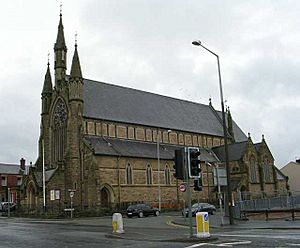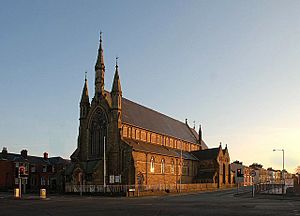Church of St Thomas of Canterbury and the English Martyrs, Preston facts for kids
Quick facts for kids English Martyrs Church |
|
|---|---|
| Church of St Thomas of Canterbury and the English Martyrs, Preston | |
 |
|
| Lua error in Module:Location_map at line 420: attempt to index field 'wikibase' (a nil value). | |
| OS grid reference | SD5367730545 |
| Location | Preston, Lancashire |
| Country | United Kingdom |
| Denomination | Roman Catholic |
| Website | StJohnXXIIIPreston.com |
| History | |
| Status | Shrine church |
| Founded | January 22, 1865 |
| Founder(s) | Bishop Alexander Goss |
| Dedication | St Thomas Becket and the English Martyrs |
| Dedicated | 1 December 1867 |
| Consecrated | 14 September 1921 |
| Architecture | |
| Functional status | Active |
| Heritage designation | Grade II |
| Designated | 2 September 1985 |
| Architect(s) | Edward Welby Pugin |
| Style | Gothic Revival |
| Groundbreaking | 26 May 1866 |
| Completed | 9 February 1888 |
| Specifications | |
| Capacity | 850 |
| Length | 154 ft (47 m) |
| Width | 92 ft (28 m) |
| Height | 69 ft (21 m) |
| Administration | |
| Parish | St John XXIII |
| Deanery | Preston |
| Diocese | Lancaster |
| Province | Liverpool |
English Martyrs Church is a Roman Catholic church in the city of Preston, Lancashire. Its full name is The Church of St Thomas of Canterbury and the English Martyrs. It was designed by the famous architect Edward Welby Pugin.
The church is a special place of worship known as a shrine church. It is located near Preston's city centre, on a corner of the main A6 road.
Contents
The Church's Long History
The story of the church begins long before it was built, on a piece of land with a dark past.
A Place Called Gallows Hill
The church stands on a site that was once known as Gallows Hill. It got this name after the Battle of Preston (1715), which was part of a conflict called the Jacobite rising of 1715. After the battle, captured soldiers were executed on this hill.
In 1817, workers digging up the road found two coffins. Inside were the remains of two bodies without heads. They also found a brass axe and pieces of wood, which people believe were part of the gallows used for the executions.
A Chapel in a Stable
In 1864, a Catholic mission was started in the area. The leader of the church in Liverpool, Bishop Alexander Goss, sent a priest named Father James Taylor to a house called Wren's Cottage.
The priest lived in the cottage, and the stable was turned into a small chapel. The first Mass was held there on Christmas Day in 1864.
Building a Grand New Church
The stable chapel was very small and could only hold about 145 people. As more people came to worship, it was clear a much larger church was needed. The land at Gallows Hill was chosen as the site for the new building.
On May 26, 1866, Bishop Goss laid the first stone, called the foundation stone. The church was designed by Edward Welby Pugin, whose father, Augustus Pugin, was also a very famous architect. The original plan included a tall spire, but there wasn't enough money to build it.
The church officially opened on December 1, 1867.
Making the Church Even Bigger
In 1886, a new priest named Father Joseph A. Pyke saw that the church was once again too small for its growing congregation. He decided to make it bigger and hired the same architect, Edward Welby Pugin, to design the extension.
The new plans added more space to the main hall (the nave), a new area for the altar (the chancel), and side sections called transepts. The changes would cost about £8,000.
The building work was finished in 1888. A grand re-opening ceremony was held on February 8, 1888, with many important church leaders attending.
Becoming a Consecrated Church
After Father Pyke, his nephew, Father Edward J. Pyke, took over. He worked hard to pay off all the money owed from building and extending the church.
On September 14, 1921, a special ceremony called a consecration was held. This ceremony, led by the Archbishop of Liverpool, officially made the church a sacred and holy place.
The Church in Modern Times
In 2012, the priest's house next to the church, called the presbytery, became a home for L'Arche. This is a charity that supports people with learning disabilities. Old furniture and paintings from the house were sold at an auction.
From 2017 to 2024, the church was cared for by a religious group called the Institute of Christ the King Sovereign Priest. This group also looks after another historic church in Preston, the St Walburge's Church.
Parish and School
The church is part of a local Catholic community called a parish. Near the church is the English Martyrs Catholic Primary School. The school aims to follow the teachings of Jesus Christ.
See also
- Listed buildings in Preston, Lancashire


